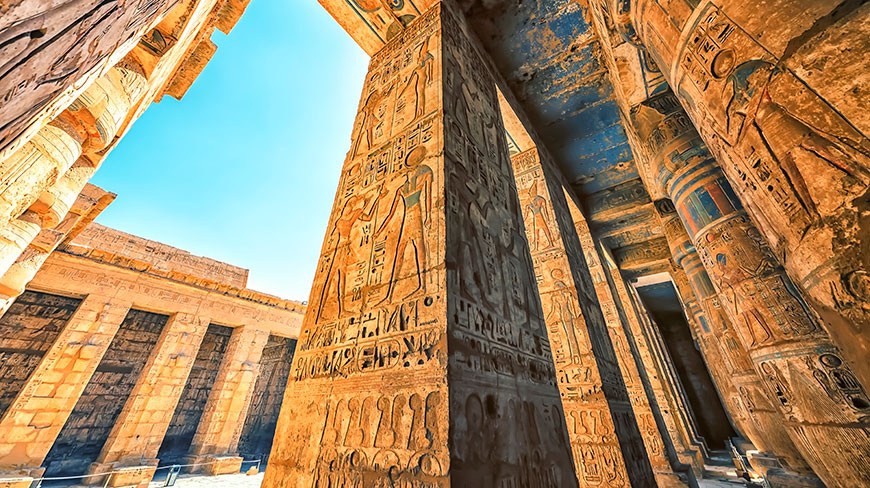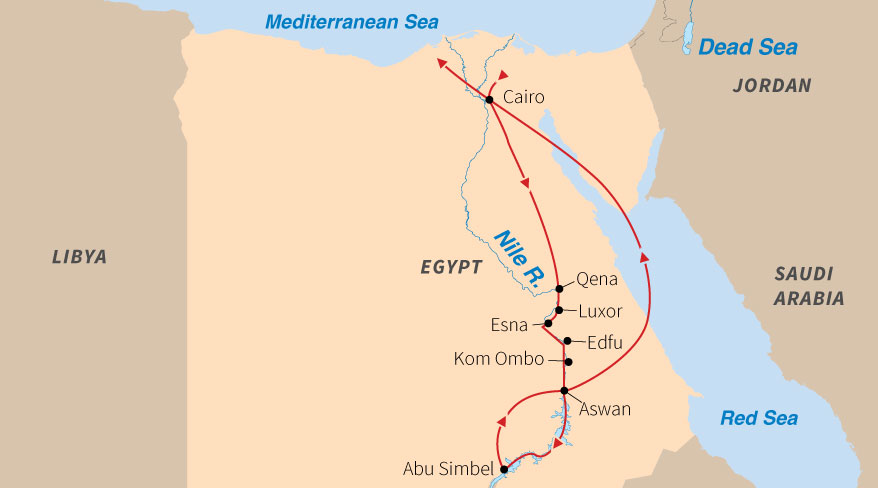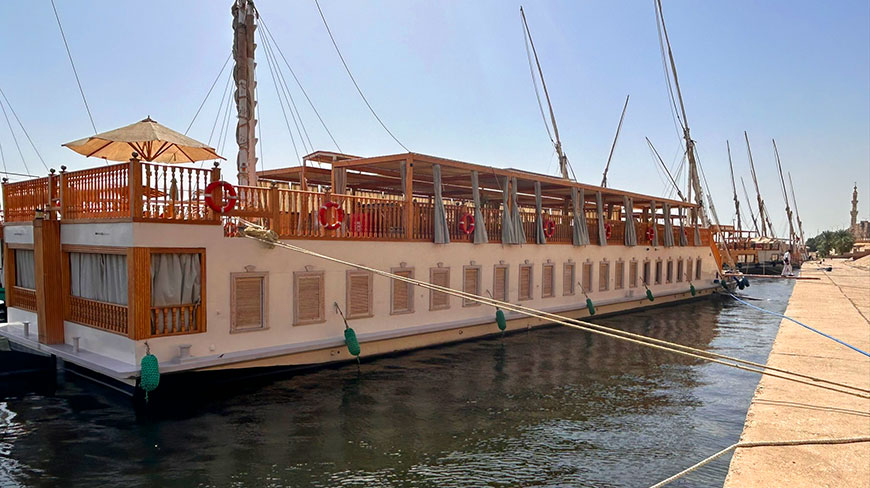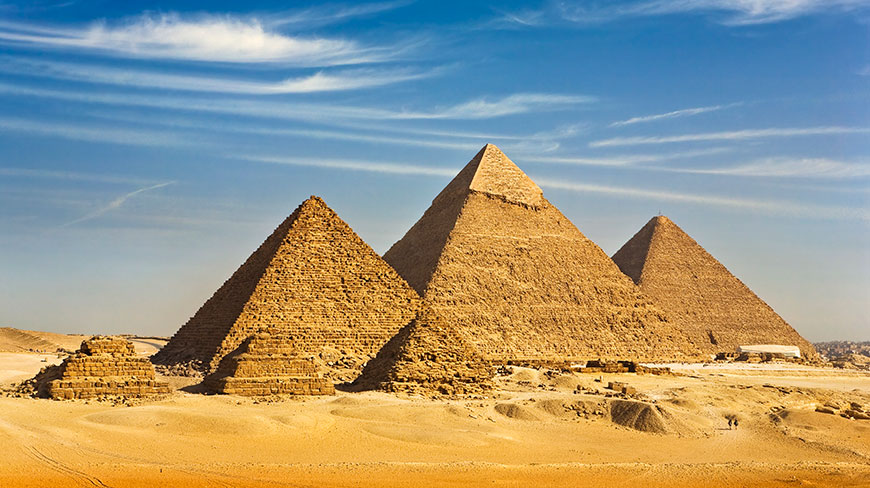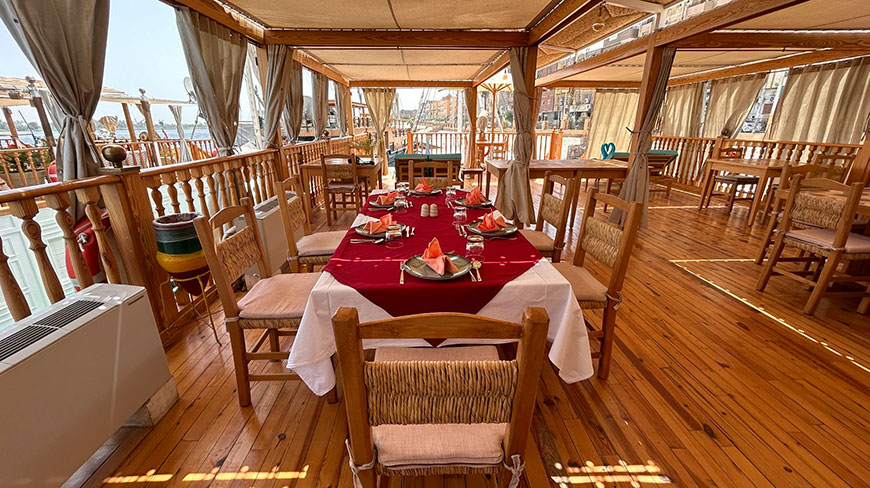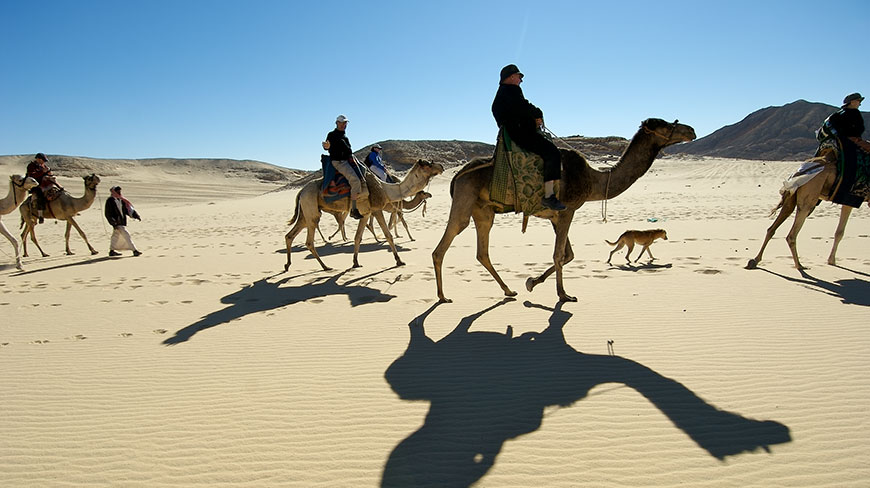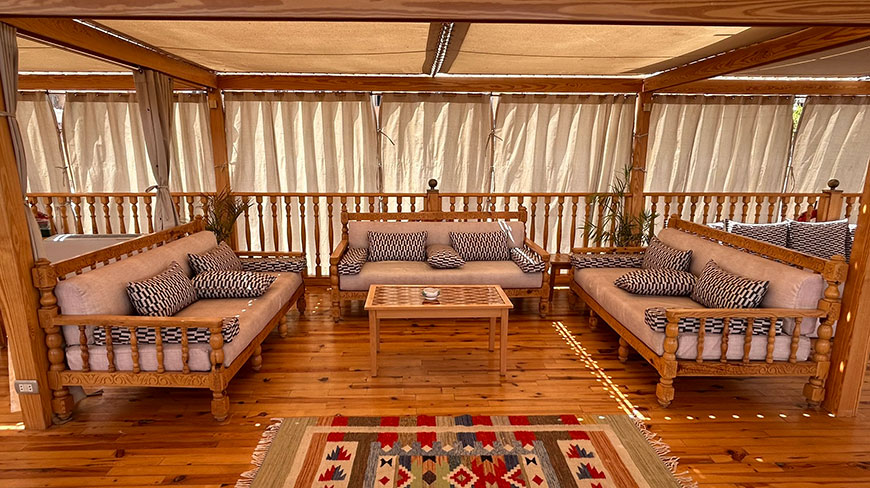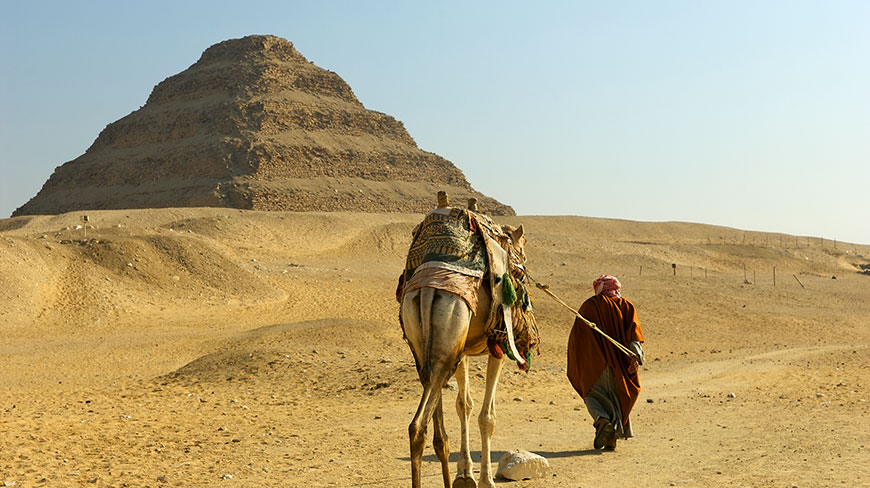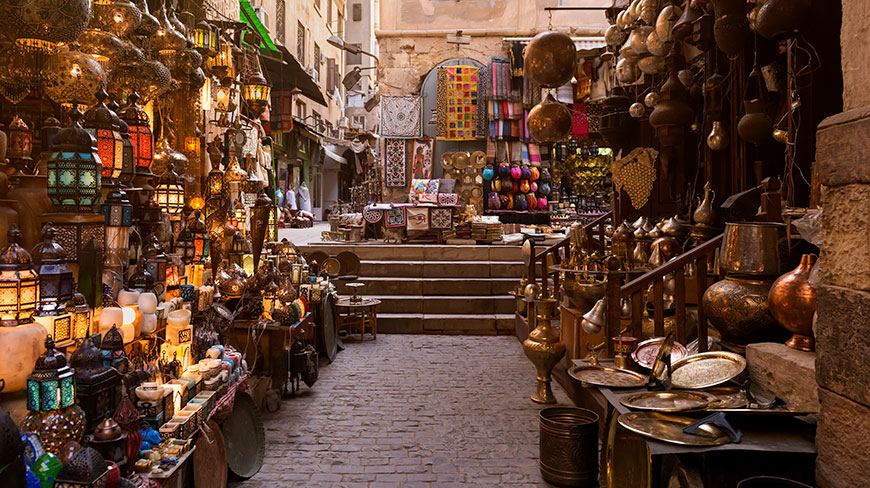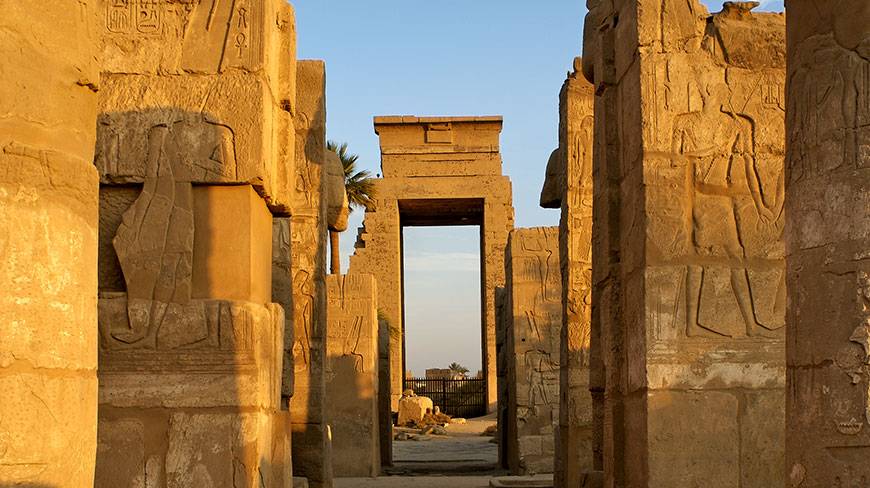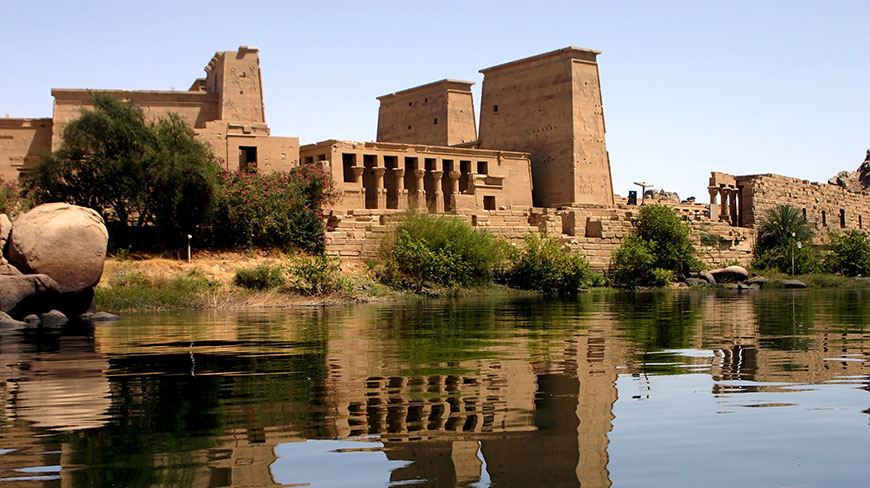Egypt
Up the Nile & Into History: Sailing Through the Stories of Egypt
Program No. 25131RJ
On the ultimate adventure in Egypt, sail along the Nile aboard a modern dahabeya, explore the Valley of the Kings and learn about Egyptian history at the Great Pyramid of Giza.
Itinerary
While we make every effort to ensure the accuracy of our published materials, programs are typically advertised more than a year prior to their start date.
Read More.
All itineraries and excursions are subject to change. Weather and water conditions may affect the progress of the ship, and we may miss ports if it is not safe to dock. The operators reserve the right to change the content and duration of excursions without prior notice and so the cruise itinerary should always be regarded as provisional. Whenever possible, Road Scholar’s published daily schedule will indicate port arrival and departure times. Prior to departure, if there is a major change, we will make every effort to alert you. For less significant changes, we will update you during orientation. Thank you for your understanding.
Duration
13 days
12 nights
What's Included
31 meals (
11B, 10L, 10D
)
2 expert-led lectures
16 expert-led field trips
4 flights during the program
An experienced Group Leader
11 nights of accommodations
Taxes and customary gratuity
Road Scholar Assurance Plan
Day
1
In Transit to Program
Location:
In Flight
Day
2
Arrive Cairo, Check-in, Welcome Dinner
Location:
Cairo
Meals:
D
Stay:
Kempinski Nile Hotel
Activity Note
Hotel check-in from 2:00 p.m. Remember to bring your nametag (sent previously). This program is not suitable for participants using wheelchairs, scooters, walkers, or other mobility assistance devices.
Afternoon:
After checking in at the hotel, take some time to relax and settle into your room. Later in the afternoon, we will meet our Group Leader and fellow Road Scholars ahead of dinner.
Dinner:
At the hotel.
Evening:
At leisure. Continue getting to know your fellow Road Scholars, settle in, and get a good night’s rest for the day ahead.
Day
3
Orientation, Grand Egyptian Museum, Nile Lecture
Location:
Cairo
Meals:
B,L,D
Stay:
Kempinski Nile Hotel
Activity Note
Getting on/off a bus. The visit to the museum will be approximately 2-3 hours and includes various steps without railings to the first floor.
Breakfast:
At the hotel.
Morning:
Orientation. The Group Leader will greet everyone and lead introductions. We will review the up-to-date program schedule, discuss roles and responsibilities, logistics, safety guidelines, emergency procedures, and answer questions. Our experienced and knowledgeable Group Leader will also serve as our Study Leader, presenting lectures and conducting field trips along with local experts. Periods in the schedule designated as “Free time” and “At leisure” offer opportunities to do what you like and make your experience even more meaningful and memorable according to your personal preferences. The Group Leader will be happy to offer suggestions. Program activities, schedules, personnel, and indicated distances or times may change due to local circumstances/current conditions. In the event of changes, we will alert you as quickly as possible. Thank you for your understanding. With the Group Leader, we will enjoy a visit to the Grand Egyptian Museum, which houses the largest collection of pharaonic antiquities in the world. The museum displays an extensive collection spanning from the Predynastic Period to the Greco-Roman era. The museum also houses the splendid statues of the great kings Khufu, Khafre, and Menkaure, whose tombs lie in the pyramids of the Giza plateau. An extensive collection of papyri, sarcophagi, and jewelry—among other objects—completes this uniquely expansive museum.
Lunch:
At a local restaurant.
Afternoon:
We will return to the hotel where we will enjoy a presentation on Egypt and the Nile by a professor from Cairo University.
Dinner:
At a local restaurant.
Evening:
At leisure.
Day
4
Great Pyramids of Giza, Sphinx & Camel Ride
Location:
Cairo
Meals:
B,L
Stay:
Kempinski Nile Hotel
Activity Note
Getting on/off a bus; driving 20 miles each way, under 1.5 hours total riding time. Walking up to 2 miles on uneven and rough terrain; standing for up to 1/2 hour in hot conditions with no shade at each site. Getting on/off a camel for a short ride.
Breakfast:
At the hotel.
Morning:
Led by our Egyptologist, we will set out by bus to explore the most renowned sites of Egypt: the Great Pyramids of Giza and the Sphinx. We’ll start with an exploration of the Valley of Giza, a marvel of architectural prowess. The three largest pyramids in the valley consists of the Great Pyramid of Khufu, the Pyramid of Kafhre, and the Pyramid of Menkaura – all tombs dedicated to different Egyptian kings. We will then head to the Sphinx of the Giza Plateau, the most famous sphinx in the world. This iconic statue has been guarding the necropolis for centuries and is believed to depict the face of Pharaoh Khafre. We’ll enjoy a wonderful opportunity to see the sites from a panoramic viewpoint and experience a unique short camel ride.
Lunch:
At a local restaurant.
Afternoon:
After lunch, we will set out to explore Saqqara, the necropolis for the ancient Egyptian capital of Memphis. Here with the Group Leader, we will see the step pyramid complex of the pharaoh Djoser, built more than 4,700 years ago and considered the oldest stone structure on Earth. This pyramid was built for the burial of Djoser and was designed and commissioned by his vizier and high priest of the god Ra, Imhotep. Next, we will visit the Pyramid of Teti. Although the original height of this pyramid is believed to have been 172 feet, the preservation above ground is poor and now mostly resembles a small hill. Inside, however, we will see some marvelous pyramid texts inscribed around the walls of the burial chamber and inner corridors. These are some of the oldest texts found belonging to the Old Kingdom, dating to around 2300 BCE. Although Saqqara is home to many royal burials, this was not a royal necropolis exclusively. Among many of the tombs found in this valley, we will find the tomb of Kagemni, chief justice and vizier who served under the reign of Pharaoh Teti. While kings began to be buried in pyramids during the Old Kingdom, Kagemni’s tomb is still in the old “stone bench” shape tomb known as a mastaba. After our visit, we will return to the hotel.
Dinner:
This meal has been excluded from the program cost and is on your own to have what you like. The Group Leader will be happy to offer suggestions.
Evening:
At leisure.
Day
5
Historic Cairo
Location:
Cairo
Meals:
B,L,D
Stay:
Kempinski Nile Hotel
Activity Note
Getting on/off a bus; driving 15 miles each way, approximately 1 hour total riding time. Walking up to 3 miles on uneven and rough terrain; standing for up to 1 hour in hot conditions with no shade at each site. There are some steps without railings to enter the monastery, and please note that you will be asked to remove your shoes before entering the church.
Breakfast:
At the hotel.
Morning:
After breakfast, we will head out with the Group Leader by bus towards the oldest part of the city, known locally as Masr al-Qadima or “Old Cairo.” Part of this area has been a stronghold of Christianity since the Roman period and is known colloquially as “Coptic Cairo”. During our visit here, we will enjoy a field trip to Saints Sergius and Bacchus Church (also known as Abu Serga) and the Hanging Church, two of the most famous and oldest Coptic churches in all of Egypt. The former is believed to have been built in the spot where the Holy Family rested at the end of their journey to Egypt and is where many patriarchs of the Coptic Church have been elected and consecrated. We will then continue to Ben Ezra Synagogue, established in Coptic Cairo in 1115 in what a Coptic church was previously built in the 8th century. The building was sold to the Jewish community of Egypt in 882 and is named after prominent Jewish religious scholar Abraham Ibn Ezra. Ben Ezra Synagogue is the oldest synagogue in all of Egypt and is where the Cairo Geniza – the largest and most important single collection of medieval Jewish manuscripts – was discovered in 1896.
Lunch:
At a local restaurant.
Afternoon:
We will visit the Mosque of Ibn Tulun, built in 879 and one of the oldest mosques in all of Africa. This mosque is the only surviving structure of the city of al-Qata’i, which served as the capital of the short-lived Tulunid dynasty from 868-905. We will then head towards El-Moez Street, the most important street of Islamic Cairo. Dating to the 10th century, El-Moez was the main street where markets and shops flourished. Today this area is still populated by multiple shops and has rich evidence of ancient Islamic architecture. Among one of the most popular places located on El-Moez is Khan el-Khalili Bazaar, originally founded as a center of trade during the Mamluk era. Today, this bazaar is home to many Egyptian artisans and workshops and is one of the most popular shopping districts of Cairo. After a short visit, our Group Leader will give us some time to explore this area on our own and interact with locals. Afterwards, we will return by bus to the hotel where we will enjoy a lecture on Egyptian social life by a guest professor.
Dinner:
At the hotel.
Evening:
At leisure. Prepare for check-out and our flight to Luxor in the morning.
Day
6
Flight to Luxor, Karnak Temple, Embarkation
Location:
Qena
Meals:
B,L,D
Stay:
Queen of Egypt
Activity Note
This day includes an early morning start. Getting on/off a bus; driving 20 miles, over 1 hour riding time. Getting on/off an aircraft; the flight from Cairo to Luxor is 1 hour long. Walking up to 3 miles on uneven and rough terrain; standing for up to 1 hour in hot conditions with no shade at each site. At Karnak, there are a few steps without railings. Embarking the ship.
Breakfast:
Boxed breakfast from the hotel.
Morning:
We will transfer early by bus to the Cairo Airport for our flight to Luxor. Upon arrival, we will depart to explore the temple complex of Karnak. Also known as “ipet-isut” or “the most sacred of places,” it is the largest temple complex ever built and represents the combined achievements of 13 centuries of builders. Among the gods venerated at this site were Amun-Re, his wife Mut, and their son Montu. After our field trip, we will depart by bus to board the ship for lunch and check-in.
Lunch:
On board.
Afternoon:
The rest of the afternoon is reserved for a scenic sail to Qena in Upper Egypt. Relax and settle into your cabin.
Dinner:
On board.
Evening:
At leisure.
Day
7
Dendera & Luxor Temples
Location:
Sailing on Nile
Meals:
B,L,D
Stay:
Queen of Egypt
Activity Note
Getting on/off a bus; driving 25 miles, over 1/2 hour riding time. Walking up to 3 miles on uneven and rough terrain; standing for up to 1 hour in hot conditions with no shade at each site.
Breakfast:
On board.
Morning:
After breakfast, we will head out by bus to visit one of the major archaeological sites in Egypt, the Temple of Dendera. Dating to the Ptolemaic Period, it is dedicated to the one of the most popular goddesses in ancient Egypt, Hathor, who was associated with music, dance, joy, and motherhood. The Temple is decorated with six massive columns ornate with the head of Hathor at the entrance. The ceilings were decorated with different astrological and astronomy scenes, which is major evidence of Egyptians’ knowledge of astronomy. Following the field trip, we’ll return to the ship.
Lunch:
On board.
Afternoon:
The rest of the afternoon is reserved for a scenic sail back to Luxor. Before dinner, we will go on a field trip to Luxor Temple. Also known as “ipet-resyt” or “the southern sanctuary,” it was the center of one of the most important religious festivals in ancient Egypt—the Opet Festival—during which the statues of Amun-Re, Mut, and Khonsu were carried from Karnak to Luxor. Some scholars have also proposed that Luxor Temple differs from other temples in the region, as they argue it was centered not on the cult of a deity or deceased pharaoh, but on the cult of the current king on Earth. Academics even argue that Luxor Temple may have been the site where many of the pharaohs of Egypt were crowned kings. We’ll then return to the ship for dinner.
Dinner:
On board.
Evening:
At leisure.
Day
8
Valley of the Kings & Hatshepsut Temple
Location:
Esna
Meals:
B,L,D
Stay:
Queen of Egypt
Activity Note
Getting on/off a bus; driving 20 miles, approximately 1 hour total riding time. Walking up to 3 miles on uneven and rough terrain; standing for up to 1 hour in hot conditions with no shade at each site. The terrain is hilly and there are many steps without railings in both the Valley of the Kings and Hatshepsut’s Temple.
Breakfast:
On board.
Morning:
Led by our Group Leader, we will discover the Valley of the Kings, including the world-famous tomb of King Tut. This area of the west bank had been home to royal burials since 2100 BCE, but it was the pharaohs of the New Kingdom period (1550-1069 BCE) who began to construct elaborate tombs to reflect their newfound power and prosperity after the reunification of Egypt under Theban rule. The Valley of the Kings is home to 63 magnificent royal tombs, each unique in their own way. Before we depart the Valley of the Kings, we will enjoy a short visit to the famous Colossi of Memnon. These massive twin statues depict Pharaoh Amenhotep III and stand in what was once the entrance to the Mortuary Temple of Amenhotep III. Unfortunately, the temple was destroyed by an earthquake shortly after its construction in 1200 BCE, leaving only the famous statues behind. Stories claim that another earthquake in 27 BCE damaged the foundation of the northern colossus, causing it to “sing” on various occasions – usually heard by travelers around dawn. Greek scholars and travelers quickly took to calling the statue the “colossus of Memnon” since the mythological hero of Memnon was a king in the region and said to be the son of Eos, the goddess of dawn. After our visit to the valley, we will venture nearby to the iconic Temple of Queen Hatshepsut. A marvel of ancient architecture, this mortuary temple was built by Pharaoh Hatshepsut and dedicated to herself and the god Amun.
Lunch:
On board.
Afternoon:
Enjoy some free time aboard as we sail to Esna. This afternoon, we’ll gather with the Group Leader to learn more about current life in Egypt. The Group Leader will be more than happy to share information and answer questions.
Dinner:
On board.
Evening:
At leisure.
Day
9
Esna Temple, Esna Village, El Kab
Location:
Edfu
Meals:
B,L,D
Stay:
Queen of Egypt
Activity Note
Getting on/off a bus; driving 25 miles, over 1 hour total riding time. Walking up to 3 miles on uneven and rough terrain; standing for up to 1 hour in hot conditions with no shade at each site.
Breakfast:
On board.
Morning:
Led by our Group Leader, we will head out by bus explore the temple of Esna, one of the most recent as it dates to the second century BCE, first erected under Pharaoh Ptolemy VI. Phorones from this dynasty are known for representing the great mixture of Greek and Egyptian cultures. It is attributed with a dedication to Khnum, god of fertility and the source of the Nile; later, the vestibule was built during the reign of the Roman emperor Claudius. The temple recently underwent a major restoration, which reveals the beauty of this ancient artwork. We will explore Esna village before returning to the boat to sail towards El Kab.
Lunch:
On board.
Afternoon:
Enjoy some free time aboard as we approach El Kab, once called Nekheb, a major town and one of Upper Egypt’s oldest settlements. It was an important seat of the royals from the 18th dynasty, and was fundamental to preserving the city of Nekhen, which ended up becoming the larger administrative center over time. It is symbolic for royalty of the South, represented by the tutelary goddess Nekhbet, the patron of Upper Egypt. At this site, many of the tombs and accompanying art were discovered by archaeologists. After our visit on foot with the Group Leader, we’ll return to the ship and continue sailing towards Edfu.
Dinner:
On board.
Evening:
At leisure.
Day
10
Edfu, Gabal el Selsela
Location:
Komb Ombo
Meals:
B,L,D
Stay:
Queen of Egypt
Activity Note
Getting on/off a bus. Walking up to 2 miles on uneven and rough terrain; standing for up to 2 hours in hot conditions with no shade at each site. There are over 50 steps without railings at historic sites.
Breakfast:
On board.
Morning:
We will begin our day with a visit via bus to Edfu, a prominent Ptolemaic period temple. Dedicated to falcon god Horus, the Temple of Edfu is one of the largest and best-preserved temples in all of Egypt. The inscriptions on the walls of the temple have provided meaningful insight to the language and religion of the Hellenistic period of Egypt, as well as some of the construction techniques used by architects at the time. This day may include rides on horsedrawn carriages but could be substituted by a bus ride depending on availability. Later, we will return to the ship where we will set sail for Gabal el Selsela.
Lunch:
On board.
Afternoon:
We will visit Gabal el Selsela with the Group Leader. This long-used quarry site, from at least the 18th dynasty to Roman times, was called Khenu, or “the place of rowing,” as it is the site where the cliffs of both sides of the Nile are narrowing. Then, our sail continues to Kom Ombo.
Dinner:
On board.
Evening:
At leisure.
Day
11
Kom Ombo & Philae Temples, Nubian Museum
Location:
Aswan
Meals:
B,L,D
Stay:
Queen of Egypt
Activity Note
Getting on/off a bus; driving 35 miles, over 1 hour riding time. Walking up to 1.5 miles on uneven and rough terrain; standing for up to 1 hour in hot conditions with no shade at each site. There are approximately 40 steps at historic sites without railings.
Breakfast:
On board.
Morning:
We will head out on the bus for Kom Ombo Temple. Built during the Ptolemaic dynasty in the 2nd century BCE, this temple is highly unusual because of its symmetrical “double” design. All the rooms of the temple are duplicated, mirrored among the building’s main axis. The southern half of the building was dedicated to the crocodile god Sobek, while the northern part of the building was dedicated to falcon god Horus. During initial excavations, more than 300 crocodile mummies were discovered at this site. Returning to the ship, we will set sail once again, this time towards Aswan.
Lunch:
On board.
Afternoon:
We will continue our afternoon with a visit to Philae Temple. “Philae” is a Greek approximation of what is described in hieroglyphic texts as “Pilak” and refers to the “island of the time of Re,” i.e., the time of creation. However, what we refer to today as Philae is the main temple complex relocated from that ancient island to the island of Agilika in the 1960s as a conservationist move to avoid the site’s loss due to flooding by the High Dam. This temple was the center of the cult of goddess Isis and her connection with Osiris, Horus, and the Kingship during the Ptolemaic period of Egyptian history. We will finish with a visit to the Nubian Museum, where the local traditions, crafts, and folklore will be introduced to us by the Group Leader, as well as many of precious artifacts witnessing historical development of Egyptian and Nubian civilizations. We will then return to the ship for our last dinner aboard.
Dinner:
On board.
Evening:
At leisure. Prepare for disembarkation and transfer in the morning.
Day
12
Abu Simbel, Fly to Cairo
Location:
Cairo
Meals:
B,L,D
Stay:
InterContinental Citystars Hotel
Activity Note
Getting on/off a bus; driving 30 miles, over 1.5 hours total riding time. Walking up to 2 miles on uneven and rough terrain; standing for up to 2 hours in hot conditions with no shade at each site. There are 20 steps at the dock to board the felucca ride. Getting on/off an aircraft; the flight from Aswan to Abu Simbel is under 1 hour and the flight back to Cairo via Aswan is up to 2 hours long.
Breakfast:
On board.
Morning:
After check-out and disembarkation, we will transfer via bus to the Aswan airport. Here, we will board a short flight towards Abu Simbel. We will depart by bus for our ride through the desert to Abu Simbel. Led by our Group Leader, we’ll spend the afternoon exploring this iconic piece of ancient architecture many argue should be the “Eighth Wonder of the World.” Abu Simbel was built in the 13th century BCE and comprises two massive rock temples, that of Ramesses II—primarily dedicated to Re-Harakhte—and that of his wife, Nefertari—dedicated to Hathor. The site was forgotten until 1813, when Swiss researcher J.L. Burckhardt accidentally found the frieze of the main temple buried in the sand. The temples were a sensation across Europe and became a must-see for all Victorians visiting Egypt at the time, even though it required a long trip up the the Nile. After the visit, we will take the flight back to Aswan.
Lunch:
A box lunch will be provided before the flight.
Afternoon:
Upon arrival at Aswan airport, we will make our connection for the flight to Cairo, where we will then transfer to the hotel for check-in.
Dinner:
At the hotel. Share favorite experiences and enjoy camaraderie with new Road Scholar friends during our farewell dinner.
Evening:
At leisure. Prepare for check-out and departure in the morning.
Day
13
Program Concludes, In Transit From Program
Location:
In Flight
Meals:
B
Activity Note
Hotel check-out by 12:00 Noon. See your program’s “Getting There” information regarding transfers.
Breakfast:
At the hotel; breakfast boxes are available to take away if departing early.
Morning:
Early morning transfer to the Cairo International Airport for return flights. This concludes our program. If you are returning home, safe travels. If you are staying on independently, have a wonderful time. If you are transferring to another Road Scholar program, detailed instructions are included in your Information Packet for that program. We hope you enjoy Road Scholar learning adventures and look forward to having you on rewarding programs in the future. Don’t forget to like our Facebook page and follow us on Instagram. Best wishes for all your journeys!

